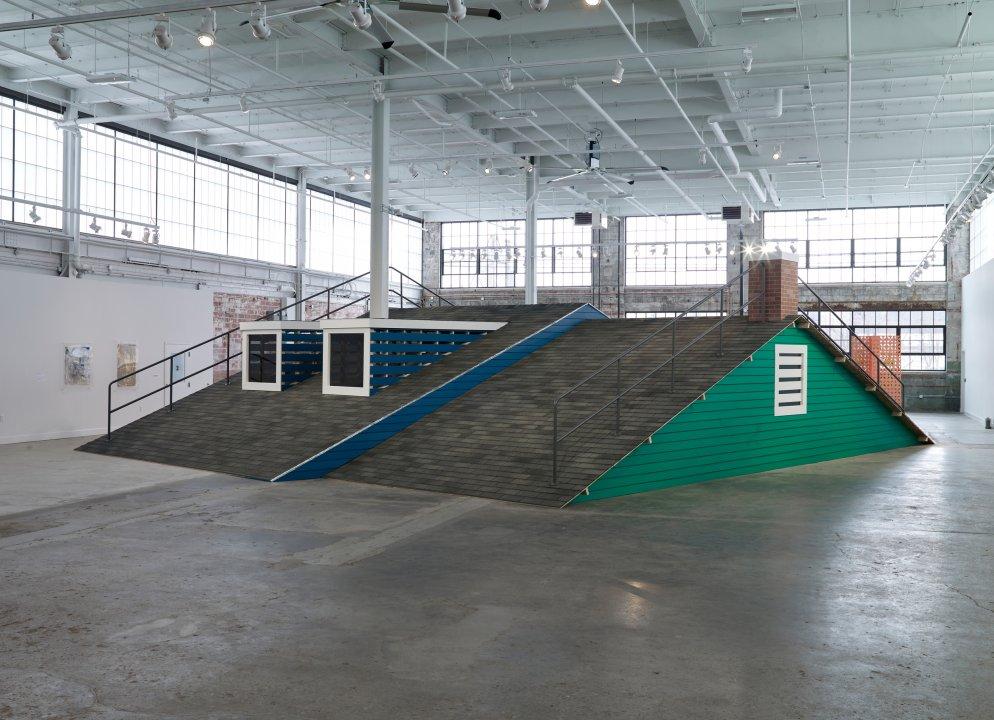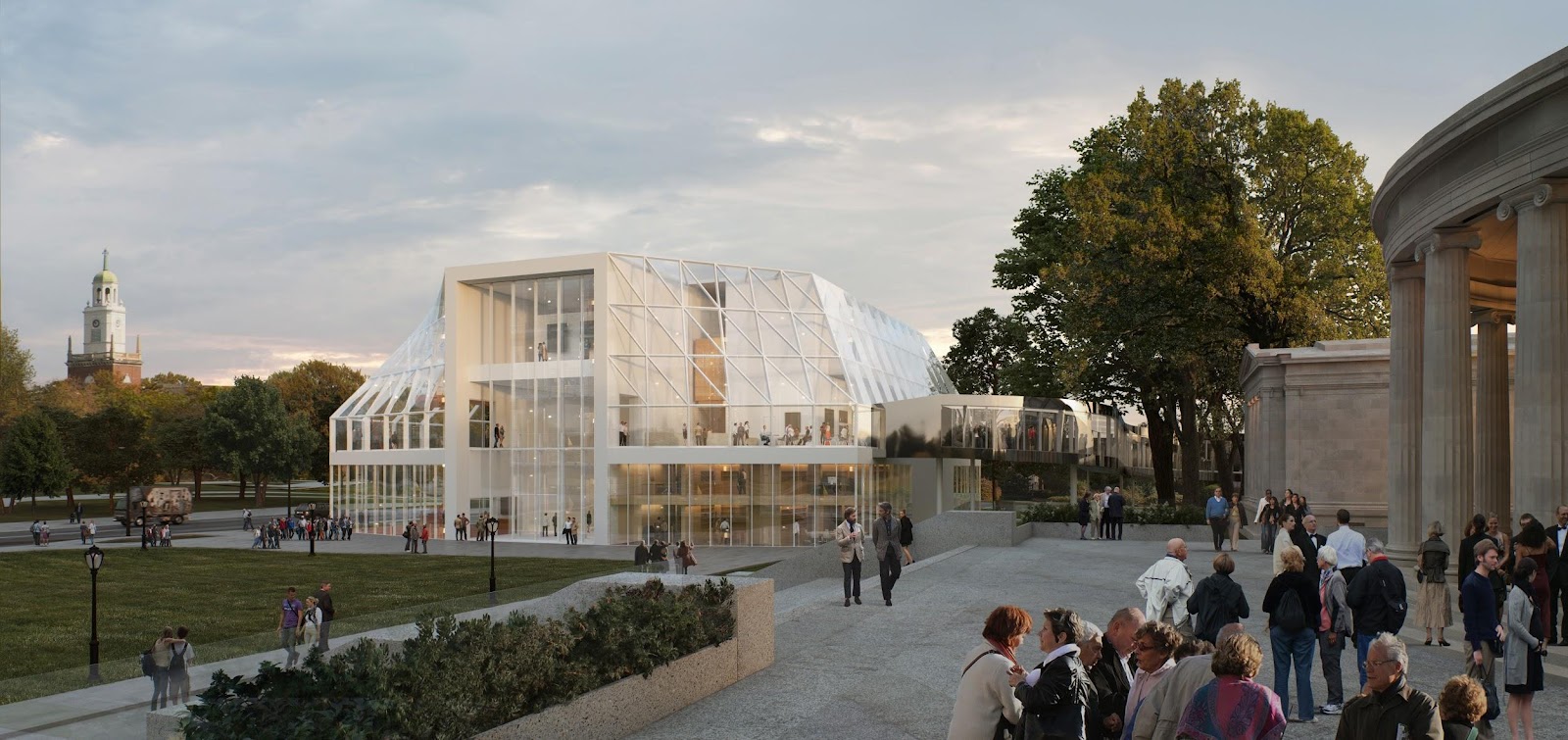Founded in 1862, Buffalo’s Albright-Knox Art Gallery is undergoing a massive expansion project scheduled to finish in 2022. It is the third major construction project in the museum’s history. While the main building is closed, the museum has sustained its engagement of its members and visitors with public art installations throughout Erie County, art programming throughout Western New York with their Art Truck, and the opening of Albright-Knox Northland, a new facility in Buffalo’s Northland Corridor.

Architectural rendering of the new 30,000 square foot addition to the 1905 building on the main Albright-Knox Campus. Image courtesy Albright-Knox Art Gallery
Off-Site, On Mission: Northland - Public Art - Art Truck
To continue to engage with artists, community members, and visitors during construction, the Albright-Knox is hosting exhibitions and events at Albright-Knox Northland. The 15,000 square-foot building is a former industrial site and is not climate controlled. Opened in January of 2020, it will offer different kinds of exhibition experiences than those presented at the main campus. This challenge is viewed as an exciting opportunity to cultivate new exhibitions and visitor experiences. “We have to think about the ways in which we engage with contemporary artists, often in a way that results in collaborative works. It also casts a wide net for our audience so that the artists can be a little bit more active with the work in the space,” said Aaron Ott, Curator of Public Art at the Albright-Knox. The first and current exhibition, Open House: Domestic Thresholds, features a life-sized replica rooftop that visitors are encouraged to climb on and explore inside. The exhibition is a collaboration between three artists, the late Rodney Taylor, Edra Soto, and Heather Hart.

Exterior of Albright-Knox Northland, a 15,000 square-foot industrial building that has been repurposed for exhibiting contemporary art, space for events and programming, and staff office space while the main Albright-Knox campus undergoes construction. Photo courtesy Albright-Knox Art Gallery

Installation view of Open House: Domestic Thresholds by Heather Hart, Edra Soto, and Rodney Taylor. Photograph by Brenda Bieger
For now, Albright-Knox Northland will continue to be home for museum staff, educational programming, and exhibitions of contemporary art on a pay-what-you-wish admission basis. “We’re doing things that are certainly what the museum has normally done, but in a different way,” said Ott. The goal for exhibitions at Northland is to re-calibrate people’s relationship with contemporary art and, as Ott hopes, their relationship with Albright Knox.
Established in 2014, the Albright-Knox Public Art Initiative, which has created more than 30 murals through Buffalo, will continue and increase throughout construction.

Louise Jones’s Wildflowers for Buffalo, 2018, at 465 Washington Street in Buffalo.
Photograph by MK Photo.
The mobile Art Truck, which launched late last year, is bringing hands-on educational programming to Western New York communities. The Albright-Knox partnered with BlueCross BlueShield of Western New York to present art classes for people of all ages and skill levels. The Art Truck will bring programs and materials to schools, libraries, parks and community centers with scheduled events and opportunities for nonprofits and for-profit organizations to request the Art Truck at their events.

The Albright-Knox Art Truck, which brings arts into local neighborhoods, was awarded a separate grant through the National Endowment for the Arts. Photo courtesy Albright-Knox
Expansion and Transformation
The expansion project will create more exhibition space to showcase the Albright-Knox collection. Before it closed, the museum was only able to exhibit 1-2% of its collection at any one time. After the expansion, the exhibition capacity will nearly double and will add a state-of-the-art space for presenting special exhibitions. Albright-Knox Director of Education & Community Engagement Dr. Jennifer Foley said that the museum has a lot of repeat visitors who have deep connections to the collection. “They often express disappointment when they visit and don’t see their favorite work,” said Foley.
AK360 will also create more space for education and events. The education classrooms will move into the 1962 building in a more visible space. These spaces will be enlarged and updated to allow the Albright-Knox Education & Community Engagement team to focus on program development for specific audiences. The 1962 open-air Sculpture Garden will be covered, converting the space into an Indoor Town Square for year-round civic engagement, open free of charge to the community during museum and program hours. “[These new spaces] will make it possible for us to think about whole new types of programming and engagement that we haven’t been able to do in the past,” said Foley. “We will be able to really think about how we can develop programming that is responsive and in tandem with our community.”

Architectural rendering by OMA/Shohei Shigematsu of a new work of signature architecture on the north end of its historic campus, which will more than double the amount of prime exhibition space. The new building will also incorporate several visitor amenities and is envisioned to have a wraparound promenade that visually connects the interior of the building with the surrounding Frederick Law Olmsted landscape. Photo courtesy Albright-Knox Art Gallery.
Getting Community Buy-In
The Albright-Knox will add 30,000 square feet of exhibition space. This new building, an impressive work of signature architecture on the north end of the museum campus, will have several visitor amenities and a wraparound promenade that will connect the interior to the surrounding Frederick Law Olmstead park. With this massive undertaking, the Albright-Knox was keen to have a positive working relationship with its neighbors and stakeholders in the community.
“We are in a neighborhood where we are surrounded by our cultural partners, the Burchfield Penney Art Center, Buffalo State College, Shakespeare in the Park which takes place in Olmsted Park behind the museum, and the Buffalo History Museum. We also have residents as neighbors,” said Maria Morreale, Director of Communications. “What we have done and what we will continue to do for those who are significant stakeholders is to keep them informed of what is happening next by inviting them to the table.” The table is actual meetings or meet and greets between neighbors and construction managers to allow the public to ask questions and for the construction team to hear concerns. “Transparency is our ultimate goal, but it also helps stakeholders get to know the construction company and contractors,” said Morreale. Additional meetings will continue as major steps in the project proceed.

Lawn view rendering of the new north building. Photo courtesy Albright-Knox Art Gallery
Economic Impact
When the Albright-Knox re-opens in 2022 as the Buffalo AKG Art Museum, it anticipates a 30-40% increase in visitors and $34 million economic impact, an anticipated 40% increase. Funding to AK360 for the total construction project will total around $165 million with $720,00 from NYS REDC, $500,00 from the National Endowment for the Arts and the National Endowment for the Humanities, and from private donations. The project has received public support from Congressman Brian Higgins and Senator Charles Schumer (who helped announce the federal funding awarded to museum) who were both impressed with what the continued growth of the museum will contribute to economic impact in Buffalo and amplify it as a destination for art and arts education. “This project was seen or perceived by them [Congressman Higgins and Senator Schumer] as being an integral part of Buffalo’s resurgence or renaissance, particularly with the anticipated economic impact of the project,” said Morreale.
Advocating for Your Institution
“Telling the story of what you’re doing to your representatives—whether it’s state, local or federal—and about the impact that your museum is having on the community is key,” said Foley. “This is why when we create partnerships between our schools, libraries, and community centers with the Art Truck, our Mayor will come to an event because we are engaging with his constituents and he wants them to know that he supports what we are doing.”
“We have very good relationships with our elected officials—we work with their staffs, we invite them to participate in our events, we value their input on and feedback about what matters to our shared constituencies, and those long standing relationships helped make our ask for support the furthest thing from a cold call,” said Carly Kirchberger, Manager of Government and Foundation Relationships. “We also invested in the data. We know a project like this will positively impact the landscape of our community, but when we made these presentations we had the numbers and information to back up this belief which in turn helped those officials make their case on our behalf.”
Opportunities to Reflect
Going through a massive building project, whether the museum is closed or partially closed, provides an incredible opportunity for museums to reflect and look at what they might want to change. “It allows time to ask questions like ‘who do we want to be when we launch as that new museum?’ or ‘ what do we want to change, add, or do differently?’ It’s important to take the time to reflect,” said Morreale.
Ahead of the project, visitor surveys and public meetings were key to help answer those questions. “It was a really useful project because what we heard from people informed those initiatives that we are implementing now which is bringing the Albright-Knox deeper into its community through public art, through Northland, and through the Art Truck,” said Morreale. “As we were thinking through how we would engage people in this period of ‘closure’ we were able to lean on all those conversations that we had in the preceding years.”
“I think that a lot of those conversations have informed how we’re thinking about what’s going to happen when we open,” said Foley. “It’s having an impact on how we’re thinking about how the future operations should be...what we turn our focus and attention to in the new museum. All of that discussion is incredibly important both in what happens in-between and what happens when we open.”
Further Reading
About the Project
https://www.albrightknox.org/campus-development/about-project
Albright-Knox Northland...new experience, visitor favorites
https://www.lancasterbee.com/articles/albright-knox-northland-new-experiences-visitor-favorites/
Schumer and Higgins announce two federal grants totaling $500,000 for Albright-Knox Art Gallery
https://www.wnypapers.com/news/article/current/2020/01/24/139857/schumer-higgins-announce-two-federal-grants-totaling-500000-for-albright-knox-art-gallery
